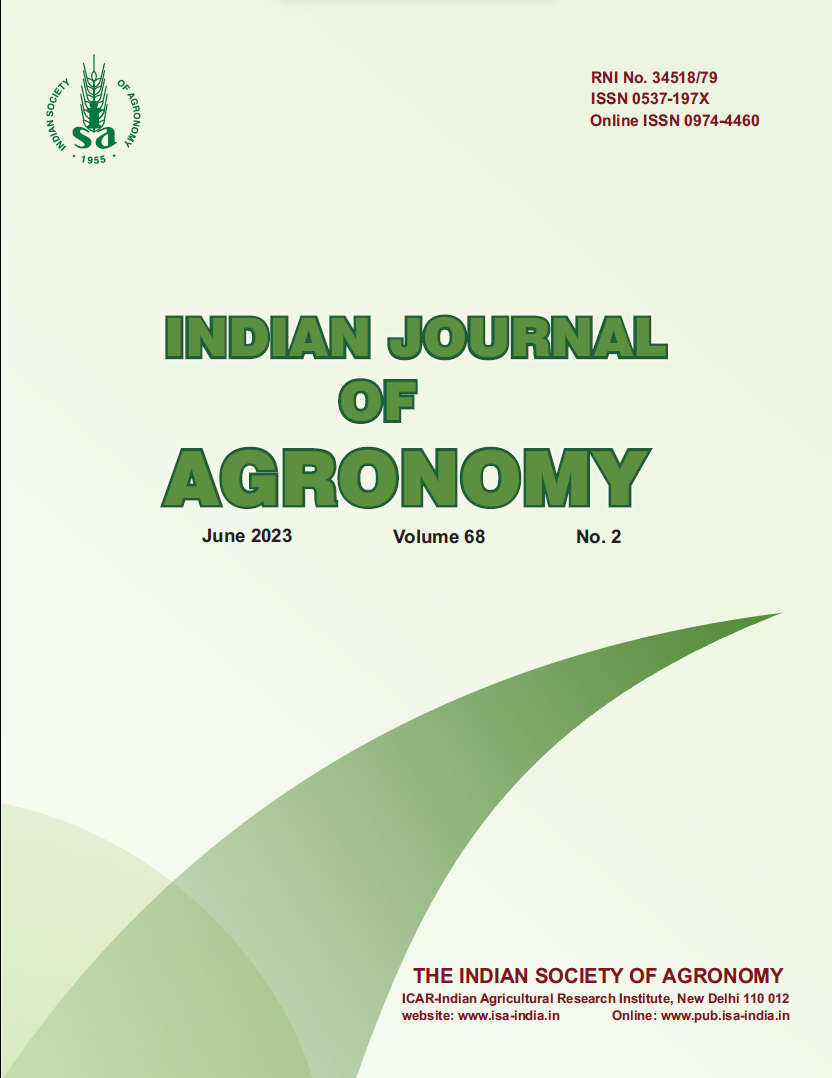Influence of fertilizer levels and wild oat (Avena ludoviciana) management on growth, yield and economics of wheat (Triticum aestivum) cultivation
DOI:
https://doi.org/10.59797/ija.v68i2.347Keywords:
Avena ludoviciana, Fertilizer level, Pinoxaden, Recommended dose of fertilizer, Wheat, Wild oatAbstract
The present study was carried out at the Chaudhary Charan Singh Haryana Agricultural University, Hisar during the winter (rabi) season of 2015–16 and 2016–17, to investigate influence of fertilizer levels and different treatments of wild oat (Avena ludoviciana Durieu.) management on growth and yield of wheat (Triticum aestivum L.). There were 24 treatments and 3 replications with fertilizer (Levels-03) and wild oat (management -08) treatments as main and subplot treatments in split-plot design. Results of the 2 year study showed, higher grain yield (44.7 q/ha), straw yield (66.7 q/ha) and benefit: cost ratio (1.80) in recommended dose of fertilizer (RDF) when compared 120% RDF (40.22 q/ha, 61.24 q/ha and 1.58 respectively). Weed-free (55.3 q/ha, 79.1 q/ha and 2.03) and pinoxaden @ 50 g/ha (54.8 q/ha, 78.6 q/ha and 2.18) being at par with each other resulted in higher grain and straw yields, whereas weedy check exhibited the least values. Clodinafop @ 60 g/ha recorded significantly higher grain, straw yield and benefit: cost (B:C) ratio than with sulfosulfuron @ 25 g/ha though it was significantly lower than the pinoxaden @ 50g/ha. Pendimethalin @ 1.5 kg/ha and metribuzin @ 175 g/ha ensued statistically similar grain, straw yield and B : C ratio, followed by weedy check. The results also indicated that, fertilizers given in larger dosages only served to increase the weed population rather than wheat output. In the higher dosage of fertilizer, weeds becomes resistant to normal dosage of herbicides. Recommended dose of fertilizer along with suitable herbicide application or manual weeding could result in higher yield of wheat.
References
Ahmadvand, G., Koocheki, A. and Mahallati, M.N. 2016. The effect of nitrogen and plant density on competitive interactions between winter wheat (Triticum aestivum) and wild oat (Avena ludoviciana). European Weed Research Society 1(4): 39–48.
Anderson, D.E. 2016. Taxonomy and distribution of the genus Phalaris. Iowa State Journal of Science 36: 91–96.
Anisha. 2014. ‘Evaluation of some herbicide mixtures against resistant Phalaris minor in wheat’. M.Sc. thesis, CCS Haryana Agricultural University, Hisar, India (unpublished).
Bhagat, S., Mukesh, K., Dhaka, A.K. and Lamba, R.A.S. 2017. Efficacy of Pinoxeden alone and in combination with metsulfuron-methyl and carfentrazone-ethyl against complex weed flora in barley (Hordeum vulgare L.). International Journal of Current Microbiology and Applied Sciences 6(4): 134–143.
Dhima, K.V. and Eleftherohorinos, I.G. 2001. Influence of nitrogen on competition between winter cereals and sterile oat. Weed Science 49: 77–82.
Di, Tomaso, J.M. 2016. Approaches for improving crop competitiveness through the manipulation of fertilization strategies. Weed Science 43: 491–497.
Dev, D., Vivek, Singh S.P. and Ravindra, K. 2014. Weed management studies in wheat (Triticum aestivum) with herbicides under different establishment methods. Indian Journal of Agronomy 58(2): 215–219.
Gholam, R.D., Hamid, R.E. and Barmak, J.H., 2015. Combined application of vermicompost and NPK fertilizers on wheat production in marvdasht. Research Journal of Fisheries and Hydrobiology 31(6): 77–79.
Gomez, K. A. and Gomez, A. A., 1984. Statical Procedure for Agricultural Research, 2nd Edn. Wiley India Private Limited, New Delhi, 680 pp.
Goudar, P., Samunder, S., Kumar, S., Kau, A. and Kumar, P. 2017. Effect of fertilizer levels and herbicides on wild oat management in wheat, pp. 188. (In) Proceedings of Biennial Conference on Doubling Farmers Income by 2022: The Role of Weed Science, 1–3 March 2017, Udaipur.
Goudar, P., Samunder, S., Rajanna, G.A. and Bhat, N.V. 2020. Influence of nitrogen fertilizers on wheat yield and wild oat competition - A review. Annals of Agricultural Research 41(4): 331–338.
Jain, N., Mishra, J.S., Kewat, M.L. and Jain,Vinamarta. 2016. Effect of tillage and herbicides on grain yield and nutrient uptake by wheat and weed. Indian Journal of Agronomy 52(3): 131–134.
James, F. and Lowell, S. 1982. Wild oat (Avenafatua) competition with wheat (Triticum aestivum and T. turgidum durum) for nitrate. Weed Science 30: 297–300.
Katara, P., Kumar, S. and Rana, S.S. 2015. Influence of pinoxaden in combination with other herbicides on nutrient depletion by weeds in wheat. Indian Journal of Weed Science 47(4): 371–375.
Kaur, R., Mahey, R.K. and Kingra, P.K. 2016. Effect of population density of Phalaris minor on production potential of wheat (Triticum aestivum). Indian Journal of Agronomy 57(2): 157–161.






